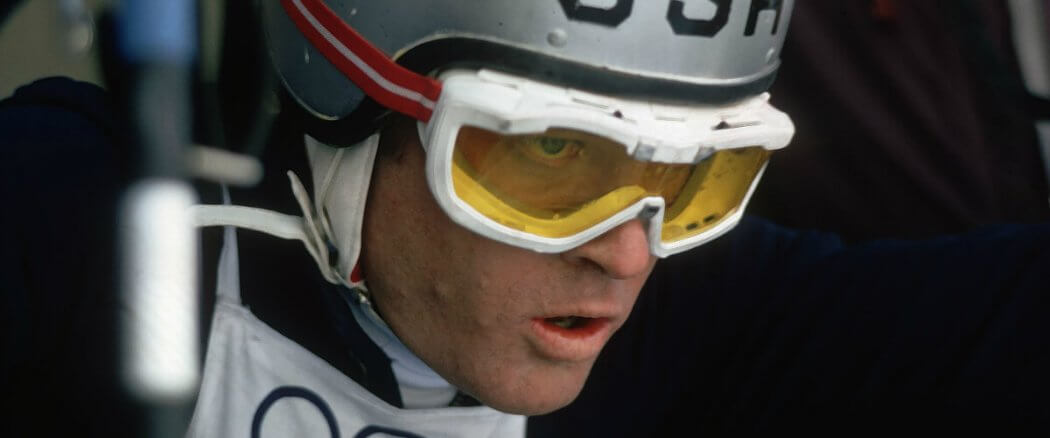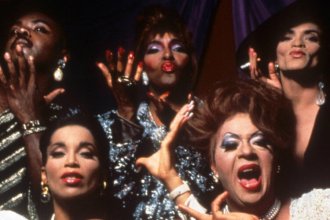In junior high, I was given the most fantastic textbook. That might seem an oxymoron to you and maybe I had low standards at the time, but it was an English textbook, and what I remember are the short stories, several of which among the best I’ve ever read. One of them, published in 1980, was by Alfred Seton, about a skier with an attitude as dangerous as the mountains. Possibly the memory of it stimulated my interest in Downhill Racer. And possibly Downhill Racer influenced Seton to write that story. It’s called “The Devil Rides With Me.”
Macbeth in Reverse
David Chappellet (Robert Redford) is from rural Colorado, but his talent, determination and, perhaps, Frenchie name, have propelled him to Europe by the start of the film, competing with and against a team of fellow American skiers coached by Eugene Claire (Gene Hackman). They’re all poised to represent U.S.A. in the upcoming Olympics, but first there are races to be won and egos to be wrangled. Chapellet’s is the wildest, and Claire attempts to subdue, then berate, then manage that ego, without affecting any change whatsoever.
It’s a cursory synopsis, and yet, sufficient, because the true plot is how dynamically the film and Redford externalize the internal. That shouldn’t be much of a surprise to anyone familiar with the screenwriter, James Salter. Honestly, I wasn’t, even though he is considered among the best postwar American novelists.* Within the first five minutes, this tale and its tone are shown, not told — a ski lift, climbing into a mountain of trees, almost like the climax of Macbeth in reverse; a skiing sequence moving at hyperspeed and freezing on certain moments — urging us to watch carefully, not be overwhelmed by the momentum.
Outrun Those Voices
“We’re all heading to the same station…” Redford declared, to Variety. “There’s a great line by T. S. Eliot: ‘There’s only the trying. The rest is not our business.’ Just keep trying. Do what you can, but don’t stop, and particularly don’t stop at that sign that says success. Run that light. Run that light.”** Redford ran on an unsustainable fuel throughout Downhill Racer, his first as producer and star, “though it never quite sunk in with people that I was producing.”*** The film has a manic energy, out of Chappellet’s control and yet utterly controlled in Redford’s performance, the latter of which is both surprising and un, considering the essential similarity between character and actor.
 “Do you still hear the negative voice of your father in your head?” Redford asked, in an interview from this year. “I still hear his voice. You don’t outrun those voices.”**** About one third into the film, Chappellet visits home, a farm in Idaho Springs, Colorado, where his father (Walter Stroud) gruffly acknowledges the arrival and returns to work. In a few short exchanges, Salter, Redford, and Stroud convey 30 some years of a relational pattern, perfectly synchronized and disassociated: Chappellet’s ache for approval and his father’s inability to express it, colluding to form a maddening loop of misunderstanding. “I just hope you don’t end up askin’ yourself the question some folks ask me,” Father mumbles, “what’s he do it for?” “Well, I’ll be famous,” Chappellet offers. “I’ll be a champion.” Father pauses, then shrugs: “World’s full of ‘em.”
“Do you still hear the negative voice of your father in your head?” Redford asked, in an interview from this year. “I still hear his voice. You don’t outrun those voices.”**** About one third into the film, Chappellet visits home, a farm in Idaho Springs, Colorado, where his father (Walter Stroud) gruffly acknowledges the arrival and returns to work. In a few short exchanges, Salter, Redford, and Stroud convey 30 some years of a relational pattern, perfectly synchronized and disassociated: Chappellet’s ache for approval and his father’s inability to express it, colluding to form a maddening loop of misunderstanding. “I just hope you don’t end up askin’ yourself the question some folks ask me,” Father mumbles, “what’s he do it for?” “Well, I’ll be famous,” Chappellet offers. “I’ll be a champion.” Father pauses, then shrugs: “World’s full of ‘em.”
Independent-spirited
Downhill Racer was “not an independent, but an ‘independent-spirited’ production.”***** Redford and company received minimal studio support, which was both limiting and liberating, in that it encouraged them to pursue absolutely the aesthetic already in mind: cinéma vérité sports. The norm for this production was anything but the norm, including hiring unprofessional actors, obtaining footage from actual races by wearing disguises and hiding equipment and handheld filming while skiing at over 50 miles an hour and holding a 40-pound camera.
The results were, as director Michael Ritchie described, “a certain freedom, a looseness, the opportunity to shoot rehearsals and use them, the facility to have the camera stretching out the action, rather than anticipating it — so that, ultimately, the audience wouldn’t be able to tell where the dramatic material left off and the documentary ski footage began.”****** And the whole experience was a catalyst in forming the sensibility that led Redford to found Sundance.
A Trap of Striving
“Downhill Racer [was] meant to be the first part of a trilogy that would deal with the same theme…” Redford explained, “in the fields of sports, politics and business…what price, the victory?”******* He never found a script for the third, but he did for the second, The Candidate, on which he and Ritchie reunited. Although Bill McKay (Redford), the eponymous nominee, is a community organizer with a heart for the people and a conscience for principles, he is still susceptible to the bait of selfish ambition, the lie that one’s worth will finally be proven, which sets a trap of striving. At the end of the film and a successful campaign, McKay, childlike, asks, “what do we do now?”
There are comparable moments in Downhill Racer, after Chappellet’s wins, as he keeps saying he feels good when clearly he feels the same as before. The film’s tagline asks, “how fast must a man go to get from where he’s at?” Maybe the better question is: how far must he fall?
__________________________________________
*Jeffrey Meyers, ”Remembering James Salter,” Sewanee Review, April 1, 2016. The screenplay originally began as an adaptation of The Downhill Racers by Oakley Hall, but “the first thing was to get rid of [Oakley’s] source novel” except for the “acerbic coach-jock relationship.” Hall is not credited. (Michael Feeney Callan, Robert Redford: The Biography, Alfred A. Knopf, 2011).
**Scott Raab, “The Robert Redford Story,” Variety, April 1, 2013
***Anthony DeCurtis, “Robert Redford,” Rolling Stone, October 6, 1994.
****Michael Hainey, “The Natural,” Esquire, October 2017
*****Lawrence J. Quirk and William Schoell, The Sundance Kid: An Unauthorized Biography of Robert Redford, Taylor Trade Publishing, 2006.
******Quirk and Schoell.
*******DeCurtis.





